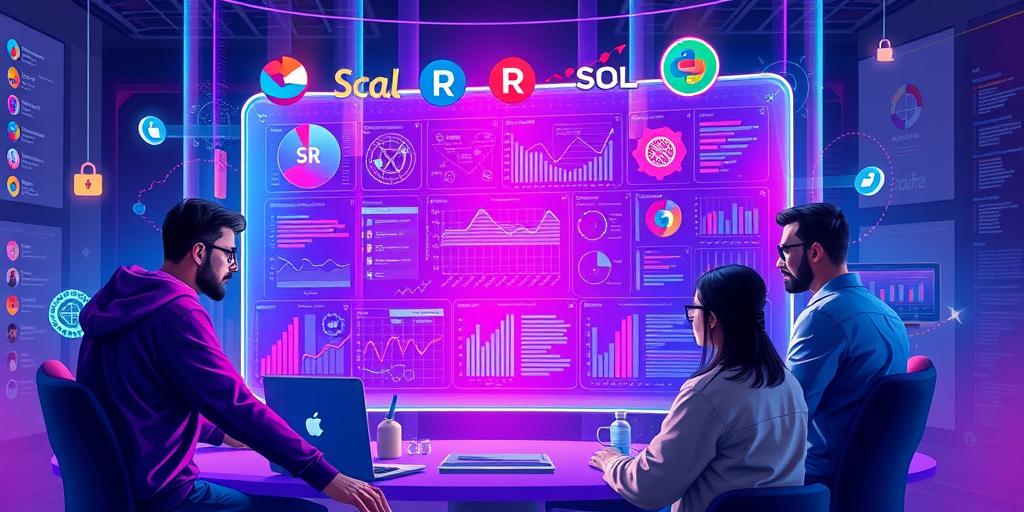Is Python the Only Language Data Scientists Should Learn? The short answer is a resounding no! While Python reigns supreme in the data science world, limiting yourself to just one language is like trying to paint a masterpiece with only one color. Discover the exciting world of other programming languages crucial for a well-rounded data scientist’s skillset. Prepare to be amazed by the power and versatility that awaits you!
Beyond Python: Essential Programming Languages for Data Scientists
Python’s popularity is undeniable—its extensive libraries like Pandas, NumPy, and Scikit-learn make it a powerhouse for data manipulation and analysis. But the data science landscape is far more diverse than just one snake! Several other languages offer unique advantages and specialized applications which can elevate your data science career to new heights. Imagine the possibilities when you’re fluent in multiple languages, opening doors to specialized projects and roles that might be inaccessible to those with a limited skill set. This isn’t just about adding to your resume; it’s about expanding your potential and becoming a truly versatile data professional.
R: The Statistical Powerhouse
R, a language specifically designed for statistical computing, provides unparalleled capabilities for data visualization and statistical modeling. Its rich ecosystem of packages, especially ggplot2 for stunning data visualizations, makes it an invaluable tool for any data scientist. Though Python is catching up, R remains the king of statistical analysis and data visualization; mastering both Python and R will make you a true data science powerhouse.
SQL: Your Database Best Friend
SQL (Structured Query Language) is not a programming language in the traditional sense, but rather a domain-specific language that interacts directly with databases. In the data science world, this is an absolutely critical skill. No matter how sophisticated your analytical techniques are, you need to be able to extract, transform, and load (ETL) data effectively from databases. SQL lets you efficiently query, manipulate, and manage large datasets, forming the backbone of most data science workflows. This crucial skill unlocks previously inaccessible data sources, and the ability to interact with data sources directly is a major asset for any data scientist.
Java: Big Data and Scalability
For handling massive datasets—the kind that often characterize big data projects—Java’s scalability and performance are hard to beat. Frameworks like Hadoop and Spark, built with Java, are critical for processing and analyzing petabytes of data, a scale unimaginable for Python alone. Java’s object-oriented nature also lends itself to building robust and maintainable data processing pipelines. As more and more data becomes available, mastering Java’s power for large scale data analysis is essential for the most advanced data science projects.
Scala: The Spark Companion
Closely related to Java, Scala is another strong choice for big data processing with Spark. Its concise syntax and functional programming paradigm make it a more modern and expressive language than Java, especially for complex data transformations. Mastering Scala complements your Java skills, providing alternative ways to interact with and manage big data, adding another powerful tool to your data science arsenal. If you’re serious about big data, Scala offers a powerful and intuitive way to handle these gargantuan datasets.
Choosing the Right Languages: A Strategic Approach
The most effective approach to building your data science skillset involves a strategic selection of languages based on your career aspirations and project needs. Focusing solely on Python while ignoring these other crucial tools limits your opportunities and could be hindering your potential to climb to the top. Consider these questions when choosing the next language to master:
What are my career goals?
Are you aiming for a role focused on statistical modeling, big data analysis, or machine learning engineering? Different roles will prioritize different languages.
What kind of projects am I working on?
If you’re working with large datasets or databases, SQL and Java are a must. If the focus is on statistical analysis and visualization, R becomes a critical component of your toolkit.
What resources are available to me?
Learning a new language requires effort and resources. Choose a language with adequate learning materials and community support.
Conclusion: Expanding Your Data Science Horizons
Becoming a versatile and in-demand data scientist requires mastering more than just one language. While Python is a cornerstone, adding R, SQL, Java, and even Scala to your arsenal opens doors to a wider range of opportunities and projects. So, embrace the challenge, expand your horizons, and unlock your full potential as a data scientist! Start learning a new language today—your future self will thank you!




